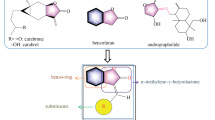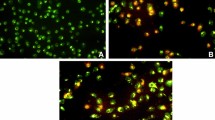Abstract
A series of 4-(substituted benzylidene-amino)-1,5-dimethyl-2-phenyl-1,2-dihydropyrazol-3-ones (1–17) was synthesized and tested in vitro for its antimicrobial and anticancer potentials. The biological screening results indicated that compounds having m-chloro substituent on benzaldehyde portion showed antimicrobial potential, whereas compounds having chloro, methoxy, and hydroxyl groups showed anticancer potential. The quantitative structure activity relationship (QSAR) studies indicated the importance of topological parameter, valence first order molecular connectivity index in describing antifungal activity. The developed QSAR models, however, were statistically insignificant with reference to anticancer activity of the synthesized compounds.




Similar content being viewed by others
References
Abdel-Jalil RJ, Momani EQE, Hamad M, Voelter W, Mubarak MS, Smith BH, Peters DG (2010) Synthesis, antitumor activity and electrochemical behavior of some piperazinyl amidrazones. Monatsh Chem 141:251–258
Bajaj S, Sambi SS, Madan AK (2005) Prediction of anti-inflammatory activity of N-arylanthranilic acids: computational approach using refined Zagreb Indices. Croat Chem Acta 78(2):165–174
Balaban AT (1982) Highly discriminating distance based topological indices. Chem Phys Lett 89:399–404
Bashkatova NV, Korotkova EI, Karbainov YA, Yagovkin AY, Bakibaev AA (2005) Electrochemical, quantum-chemical and antioxidant properties of antipyrine and its derivatives. J Pharm Biomed Anal 37:1143–1147
Bayrak H, Demirbas A, Demirbas N, Karaoglu SA (2010) Cyclization of some carbothioamide derivatives containing antipyrine and triazolemoieties and investigation of their antimicrobial activities. Eur J Med Chem 45:4726–4732
Bondock S, Rabie R, Etman HA, Fadda AA (2008) Synthesis and antimicrobial activity of some new heterocycles incorporating antipyrine moiety. Eur J Med Chem 43:2122–2129
Cappucino JG, Sherman N (1999) Microbiology—a laboratory manual. Addison Wesley, California, p 263
Cruz-Monteagudo M, Gonzalez-Diaz H, Aguero-Chapin G, Santana L, Borges F, Dominguez ER, Podda G, Uriarte E (2007) Computational chemistry development of a unified free energy Markov model for the distribution of 1300 chemicals to 38 different environmental or biological systems. J Comput Chem 28(11):1909–1923
Emami S, Falahati M, Banifafemi A, Shafiee A (2004) Stereoselective synthesis and antifungal activity of (Z)-trans-3-azolyl-2-methylchromanone oxime ethers. Bioorgan Med Chem 12:5881–5889
Emami S, Foroumadi A, Falahati M, Lotfali E, Rajabalian S, Ebrahimi FS, Shafiee A (2008) 2-Hydroxyphenacyl azoles and related azolium derivatives as antifungal agents. Bioorg Med Chem Lett 18:141–146
Furusjo E, Svenson A, Rahmberg M, Andersson M (2006) The importance of outlier detection and training set selection for reliable environmental QSAR predictions. Chemosphere 63:99–108
Golbraikh A, Tropsha A (2002) Beware of q 2! J Mol Graphics Model 20:269–276
Gonzalez-Diaz H, Prado-Prado FJ (2008) Unified QSAR and network-based computational chemistry approach to antimicrobials, part 1: multispecies activity models for antifungals. J Comput Chem 29(4):656–667
Gonzalez-Diaz H, Vilar S, Santana L, Uriarte E (2007) Medicinal chemistry and bioinformatics—current trends in drugs discovery with networks topological indices. Curr Top Med Chem 7(10):1015–1029
Gonzalez-Diaz H, Gonzalez-Diaz Y, Santana L, Ubeira FM, Uriarte E (2008) Networks and connectivity indices. Proteomics 8(4):750–778
Gupta SP, Kumar AN, Nagazappa AN, Kumar D, Kumaran S (2003) A quantitative structure-activity relationship study on a novel class of calcium-entry blockers: 1-[(4-(aminoalkoxy)phenyl)sulphonyl]indolizines. J Med Chem 38:867–873
Guzeldemirci NU, Ilhan E, Kucukbasmaci O, Satana D (2010) Synthesis and antimicrobial evaluation of new 3-alkyl/aryl-2-[((α, α-diphenyl-α-hydroxy)acetyl)hydrazono]-5-methyl-4-thiazolidinones. Arch Pharm Res 33:17–24
Hansch C, Fujita T (1964) p-σ-π Analysis. A method for the correlation of biological activity and chemical structure. J Am Chem Soc 86:1616–1626
Hyperchem 6.0 (1993) Hypercube, Inc., Florida
Judge V, Narasimhan B, Ahuja M, Sriram D, Yogeeswari P, Clercq ED, Pannecouque C, Balzarini J (2011a) Synthesis, antimycobacterial, antiviral, antimicrobial activities, and QSAR studies of isonicotinic acid-1-(substituted phenyl)-ethylidene/cycloheptylidene hydrazides. Med Chem Res. doi:10.1007/s00044-011-9705-2
Judge V, Narasimhan B, Ahuja M, Sriram D, Yogeeswari P, Clercq ED, Pannecouque C, Balzarini J (2011b) Isonicotinic acid hydrazide derivatives: synthesis, antimicrobial activity, and QSAR studies. Med Chem Res. doi:10.1007/s00044-011-9662-9
Kumar A, Narasimhan B, Kumar D (2007) Synthesis, antimicrobial, and QSAR studies of substituted benzamides. Bioorgan Med Chem 15:4113–4124
Kumar D, Judge V, Narang R, Sangwan S, Clercq ED, Balzarini J, Narasimhan B (2010a) Benzylidene/2-chlorobenzylidene hydrazides: synthesis, antimicrobial activity, QSAR studies and antiviral evaluation. Eur J Med Chem 45:2806–2816
Kumar P, Narasimhan B, Yogeswari P, Sriram D (2010b) Synthesis and antitubercular activities of substituted benzoic acid N’-(substituted benzylidene/furan-2-ylmethylene)-N-(pyridine-3-carbonyl)-hydrazides. Eur J Med Chem 45:6085–6089
Kumar D, Narang R, Judge V, Kumar D, Narasimhan B (2011) Antimicrobial evaluation of 4-methylsulfanyl benzylidene/3-hydroxy benzylidene hydrazides and QSAR studies. Med Chem Res. doi:10.1007/s00044-010-9543-7
Lather V, Madan AK (2005) Topological models for the prediction of anti-HIV activity of dihydro (alkylthio) (naphthylmethyl) oxopyrimidines. Bioorgan Med Chem 13:1599–1604
Mahle F, Guimaraes TR, Meira AV, Correa R, Cruz RCB, Cruz AB, Nunes RJ, Cechinel-Filho V, Campos-Buzzi FD (2010) Synthesis and biological evaluation of N-antipyrine-4-substituted amino-3-chloromaleimide derivatives. Eur J Med Chem 45:4761–4768
Mosmann T (1983) Rapid colorimetric assay for cellular growth and survival: application to proliferation and cytotoxicity assays. J Immunol Methods 65(1–2):55–63
Narang R, Narasimhan B, Sharma S, Sriram D, Yogeeswari P, Clercq ED, Pannecouque C, Balzarini J (2011a) Synthesis, antimycobacterial, antiviral, antimicrobial activities, and QSAR studies of nicotinic acid benzylidene hydrazide derivatives. Med Chem Res. doi:10.1007/s00044-011-9664-7
Narang R, Narasimhan B, Sharma S, Sriram D, Yogeeswari P, Clercq ED, Pannecouque C, Balzarini J (2011b) Nicotinic acid benzylidene/phenyl-ethylidene hydrazides: synthesis and antimicrobial evaluation and QSAR studies. Lett Drug Des Discov 8:733–749
Narasimhan B, Judge V, Narang R, Ohlan S, Ohlan R (2007) Quantitative structure–activity relationship studies for prediction of antimicrobial activity of synthesized 2,4-hexadienoic acid derivatives. Bioorg Med Chem Lett 17:5836–5845
Pharmacopoeia of India (2007) Controller of Publications, Ministry of Health Department, Government of India, New Delhi, vol. I: 37
Rodriguez-Arguelles MC, Lopez-Silva EC, Sanmartin J, Pelagatti P, Zani F (2005) Copper complexes of imidazole-2-, pyrrole-2- and indol-3-carbaldehyde thiosemicarbazones: inhibitory activity against fungi and bacteria. J Inorg Biochem 99:2231–2239
Rostom SAF, El-Ashmawy IM, Razik HAAE, Badr MH, Ashour HMA (2009) Design and synthesis of some thiazolyl and thiadiazolyl derivatives of antipyrine as potential non-acidic anti-inflammatory, analgesic and antimicrobial agents. Bioorgan Med Chem 17:882–895
Rosu T, Negoiu M, Pasculescu S, Pahontu E, Poirier D, Gulea A (2010) Metal-based biologically active agents: synthesis, characterization, antibacterial and antileukemia activity evaluation of Cu(II), V(IV) and Ni(II) complexes with antipyrine-derived compounds. Eur J Med Chem 45:774–789
Roy PP, Paul S, Mitra I, Roy K (2009) Two novel parameters for validation of predictive QSAR models. Molecules 14:1660–1701
Rubtsov AE, Makhmudov RR, Kovylyaeva NV, Prosyanik NI, Bobrov AV, Zalesov VV (2002) Synthesis, anti-inflammatory and analgesic activity of 4-antipyrine derivatives. Pharm Chem J 36:31–35
Rusinov VL, Kovalev IS, Kozhevnikov DN, Ustinova MM, Chupakhin ON, Pokrovskii AG, Ilicheva TN, Belanov EF, Bormotov NI, Serova OA, Volkov ON (2005) Synthesis and antiviral activity of 2-amino-3-ethoxycarbonylpyrazine derivatives. Pharm Chem J 39(12):12–16
Sabet R, Mohammadpour M, Sadeghi A, Fassihi A (2010) QSAR study of isatin analogues as in vitro anti-cancer agents. Eur J Med Chem 45:1113–1118
Santos PMP, Antunes AMM, Noronha J, Fernandes E, Vieira AJSC (2010) Scavenging activity of aminoantipyrines against hydroxyl radical. Eur J Med Chem 45:2258–2264
Sharma P, Rane N, Gurram VK (2004) Synthesis and QSAR studies of pyrimido[4,5-d]pyrimidine-2,5-dione derivatives as potential antimicrobial agents. Bioorg Med Chem Lett 14:4185–4190
Shchegolkov EV, Khudina O, Anikina LV, Burgart YV, Saloutin VI (2006) Synthesis, analgesic and antipyretic activity of 2-(antipyrin-4-yl)hydrazones of 1,2,3-triketones and their derivatives. Pharm Chem J 40:27–29
SPSS for Windows (1999) version 10.05, SPSS Inc., Bangalore, India
TSAR 3D Version 3.3 (2000) Oxford Molecular Limited
Author information
Authors and Affiliations
Corresponding author
Rights and permissions
About this article
Cite this article
Sigroha, S., Narasimhan, B., Kumar, P. et al. Design, synthesis, antimicrobial, anticancer evaluation, and QSAR studies of 4-(substituted benzylidene-amino)-1,5-dimethyl-2-phenyl-1,2-dihydropyrazol-3-ones. Med Chem Res 21, 3863–3875 (2012). https://doi.org/10.1007/s00044-011-9906-8
Received:
Accepted:
Published:
Issue Date:
DOI: https://doi.org/10.1007/s00044-011-9906-8




